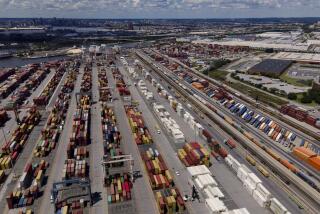Editorial: A West Coast ports pact is long past due

U.S. Labor Secretary Thomas Perez arrived in California this week to help revive stalled contract talks between international shipping companies and the dockworkers union, a stalemate that has nearly paralyzed West Coast ports. Let’s hope Perez can talk some sense into the two sides, which together are holding American businesses and the Southern California economy hostage.
The six-year contract between the International Longshore and Warehouse Union and the Pacific Maritime Assn., which represents the shipping companies and terminal operators, expired in July. Deals on wages and benefits have already been reached, but labor and management are apparently stuck over rules governing the arbitration process.
At issue is a single person — arbitrator David Miller — and a union proposal that would make it easier for either side to fire an arbitrator when a contract expires. It’s mind-boggling that commerce can grind to a halt over an issue that reasonable people should be able to reach agreement on. But as negotiations drag on, both sides have ratcheted up their rhetoric and tactics. The companies accused the union of orchestrating a work slowdown, which the union denies. The companies then stopped unloading ships over Presidents Day weekend at 29 ports from Seattle to San Diego, saying they didn’t want to pay overtime for slow work. The union blasted that decision as “irresponsible.”
To get a sense of the backlog, just look out on the ports of Los Angeles and Long Beach, where some 32 ships were anchored Wednesday, waiting to dock and unload. Shipping customers say the contract dispute is costing them billions of dollars in spoiled food, canceled deliveries and expensive workarounds, including transporting goods by air or sea to East Coast ports. This cannot continue.
The longer the slowdown, the greater the risk that businesses will find alternatives to West Coast ports. This is particularly worrisome for Southern California, home to the nation’s two busiest ports, which handle 40% of U.S. container imports. After a 2002 contract dispute and lockout, many large shipping customers opened distribution centers on the East and Southern coasts so they could move more goods through the Atlantic and Gulf ports. When the widened Panama Canal opens next year, shipping companies will be able to send larger ships to those coasts, allowing them to bypass West Coast ports entirely. To protect their competitive advantage, L.A. and Long Beach must scale up to accommodate larger ships that carry twice as many containers as the ports are used to handling.
The important work of preparing for a changing industry is stalled while the shipping companies and dockworkers are locked in a dispute. It’s time to make a deal.
Follow the Opinion section on Twitter @latimesopinion and Facebook
More to Read
A cure for the common opinion
Get thought-provoking perspectives with our weekly newsletter.
You may occasionally receive promotional content from the Los Angeles Times.






